Looking for Expert-Level VA Claim Answers?📱Call Us Now! 737-295-2226
This post is the ultimate guide to the Top 10 Easiest Service Connected Claims for VA Disability, utilizing data from the Veteran Benefits Administration’s (VBA) latest report to Congress regarding the VA disability compensation program.
VA disability compensation provides eligible veterans with a tax-free monetary benefit each month for service-connected disabilities that are the result of a disease or injury incurred or aggravated during their active duty military service.
Disability compensation may also be paid for VA disabilities that are “secondary” to disabilities occurring in service and for disabilities “presumed” to be related to circumstances of military service (e.g., burn pit exposure presumptive conditions), even though they may arise after the veteran has left active duty military service.

VA disability rates are determined by percentages for each service-connected conditions, according to a veteran’s combined VA disability rating, which is currently rated on a scale from 0% to 100%, with breaks in 10 percent increments at 10%, 20%, 30%, 40%, 50%, 60%, 70%, 80%, and 90%.
For example, a 10% VA disability rating is roughly $160 per month, while a 100% VA rating is worth more than $3,600 per month.
Generally, the more severe a veteran’s disability symptoms in terms of Frequency, Severity, and Duration, including the impairment to your work, life, and social functioning, the higher your monthly VA compensation will be.
However, some disabilities by nature impact you more than others and, therefore might garner higher ratings, and some claims for VA disability are easier than others to get service connected, which is the focus of this post, so let’s jump into it!
- Three Criteria Required to Get Your Claims for VA Disability Service Connected
- 10 Most Common VA Disability Claims
- Top 10 Easiest Things to Claim for VA Disability This Year
- #1. Tinnitus
- #2. Mental Health Conditions
- #3. Musculoskeletal Conditions
- #4. Presumptive Conditions
- List of Vietnam Veterans Presumptive Conditions
- List of Atomic Veterans Presumptive Conditions
- List of Gulf War Syndrome Presumptive Conditions
- List of Gulf War Deployed Veterans Presumptive VA Conditions to Burn Pit Exposure
- #5. Gastroesophageal Reflux Disease (GERD)
- #6. Irritable Bowel Syndrome (IBS)
- #7. Migraine Headaches
- #8. Radiculopathy
- #9. Plantar Fasciitis
- #10. Erectile Dysfunction (ED)
- Erectile Dysfunction Secondary Claims for Disability
- Medical Evidence and Supporting Documentation Are Critical
- Want to Work With a VA CLAIM EXPERT?
- About the Author
Three Criteria Required to Get Your Claims for VA Disability Service Connected
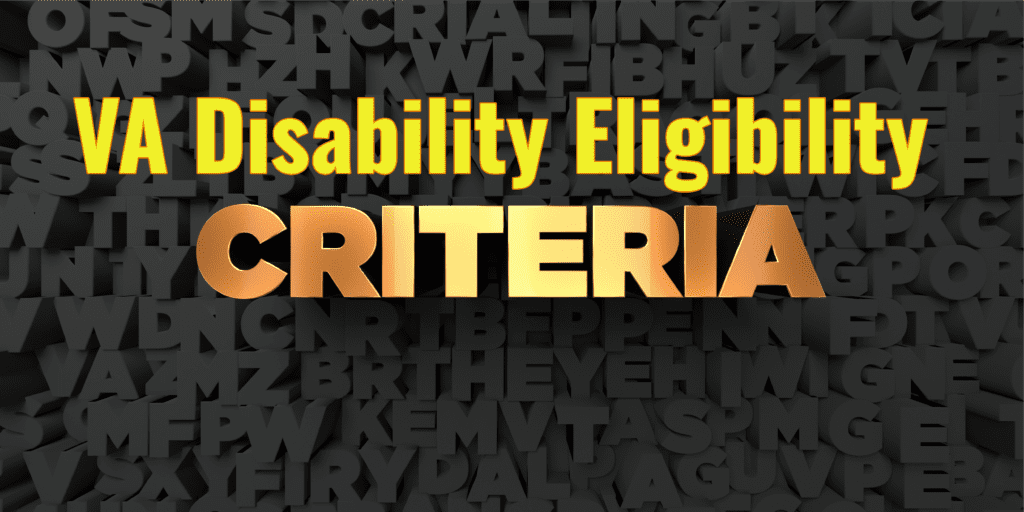
To be eligible for VA disability benefits by law, a veteran must prove three criteria under the law:
- #1. Medical Diagnosis of the disability condition in a medical record
- #2. Medical Nexus Evidence between the diagnosed disability condition and the veteran’s active-duty military service (Direct Service Connection) OR how the diagnosed disability condition is “proximately due to” or “aggravated by” another service-connected disability (Secondary Service Connection)
- #3. Current Symptoms of the disability condition that negatively affect your work, life, or social functioning (“Severity of Symptoms”)
If you’ve ever been denied service connection, it’s most likely because you failed to prove a “Nexus” exists on an “at least as likely as not” basis.
Pro Tip: “Nexus” simply means “link” or “connection.” After claim submission, the VA will likely schedule you for a Compensation and Pension (C&P) exam from a VA contracted examiner to determine if there is a link or “Nexus” between your claimed disability condition and your military service. However, you can meet this requirement independently, and typically make a much stronger case for service connection, by having a private medical professional write a credible Nexus Letter in support of your claim.
Looking For Doctors Who Write High Quality Nexus Letters? Click HERE to Join Our #1 Rated VA Claims Insider Elite Program to Get VA Nexus Letters Fast at Reduced Rates, 61-67% OFF.
10 Most Common VA Disability Claims
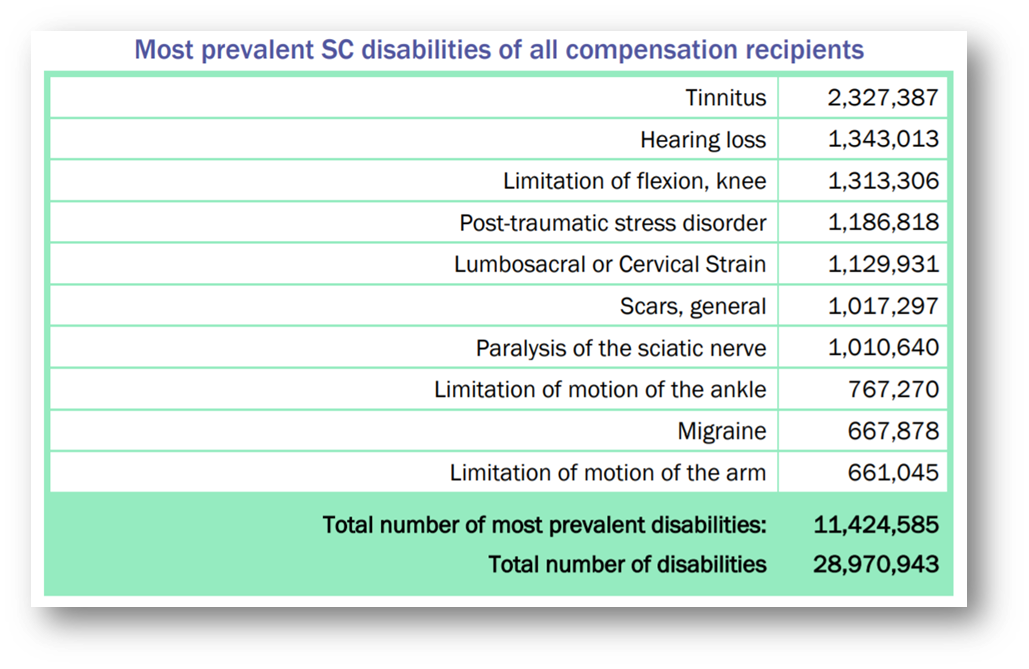
According to the Veterans Administration report to Congress, the 10 most common VA disability claims to get approved are listed in order as follows, along with the total number of veterans receiving disability compensation for each condition:
- Tinnitus – 2,327,387
- Hearing Loss – 1,343,013
- Limitation of Flexion, Knee – 1,313,306
- Post Traumatic Stress Disorder (PTSD) – 1,186,818
- Lumbosacral or Cervical Strain (Back Pain) – 1,129,931
- Scars, General – 1,017,297
- Paralysis of the Sciatic Nerve – 1,010,640
- Migraines (Headaches) – 667,878
- Limitation of Motion of the Arm – 661,045
Of these, Tinnitus is by far the easiest VA disability claim to get approved, with a total of 2,327,387 veterans service connected for the condition.
In second place is Hearing Loss, with 1,343,013 veterans service connected, followed by Limitation of Flexion of the Knee with 1,313,306.
Okay, now just because these VA claims are the most common according to VA data, that doesn’t mean they are the easiest claims to get service connected.
Alright, let’s jump into VA Claims Insider’s list of the 10 easiest things to claim for VA disability in 2023.
Top 10 Easiest Things to Claim for VA Disability This Year
While some would argue there are no easy VA disability claims, these are some of the top VA disability claims veterans are awarded service connection for.
#1. Tinnitus

Tinnitus, also known as “Ringing in the Ear Syndrome,” is not categorically a condition, but rather, a symptom of an underlying condition, such as age-related hearing loss, ear injury or a circulatory system disorder.
Tinnitus involves the sensation of hearing sound when no external sound is present.
Common Tinnitus symptoms in veterans may include “phantom noises” in your ears such as ringing, buzzing, roaring, buzzing, clicking, hissing, or humming.
The most common type of this is Subjective Tinnitus which is the kind the veteran can only hear.
Tinnitus is the #1 easiest VA claim to win and we refer to it as a “gateway claim” because it can often open the door to many other service connected conditions.
Tinnitus is a low-value claim and can only have one VA rating; it is either rated at 10% or nothing at all.
People most at risk of Tinnitus are those who work in loud conditions including musicians, elderly, and military personnel and veterans.
If you’re thinking about filing your Tinnitus claim as a secondary disability, the following conditions can cause or make Tinnitus worse: Head and neck conditions, Meniere’s disease, depression and anxiety, PTSD, TBI, Hearing Loss, Temporomandibular Joint Disorder (TMD) and high blood pressure, among others.
Pro Tip: You can also file for a host of disability conditions secondary to Tinnitus, but you’ll probably want to get a Nexus Letter to help prove service connection.
Here’s our list of the Top 5 Secondary Conditions to Tinnitus for VA Disability Benefits.
#2. Mental Health Conditions

Many veterans suffer from significant mental health issues that may be service connected for VA disability benefits.
In fact, nearly every veteran we speak to is suffering from mental health symptoms whether they realize it or not.
In addition, mental health conditions are easy VA disability claims to get approved.
There are 31 ratable mental health conditions under the law, but five of them are most common in veterans:
- PTSD (Combat, Non-Combat, & Military Sexual Trauma)
- Adjustment Disorder
- Depression
- Anxiety
- Somatic Symptom Disorder
Mental health conditions are “high-value” claims, which we define as a disability condition that has a high likelihood of getting rated at 30% or higher on their own.
In 2023, mental health conditions can be rated from 0% to 100, with breaks at 10%, 30%, 50%, and 70%.
According to the most recent VBA report to congress, a whopping 92.1% of disabled veterans rated for a mental health condition are rated at 30% or higher.
44.2% of veterans with a service connected mental health condition are rated at 70% or higher; the average VA rating for mental health is 70%.
Additionally, mental health conditions qualified the veteran for a 30% disability rating 21.9% of the time, a 50% disability rating 26.0% of the time, a 70% disability rating 30.9% of the time, and a 100% rating 13.3% of the time.
Post Traumatic Stress Disorder is an easy VA claim to get approved if you (1) Have a medical diagnosis of PTSD in a medical record and (2) Have a valid PTSD stressor event that can be verified.
Pro Tip: Many service connected physical conditions can cause or aggravate mental health conditions, and vice versa. So, if you’re already rated for another condition, consider filing a claim for a mental health condition with a Nexus Letter, assuming you and the doctor think they’re connected.
For example, PTSD can have significant debilitating effects on veterans, especially due to the side effects of medications taken to manage your PTSD symptoms, which can lead to a variety of other disabling conditions such as Sleep Apnea, Headaches, GERD, IBS, Erectile Dysfunction, and Female Sexual Arousal Disorder.
Here’s our list of the Top 5 Secondary Conditions to PTSD.
#3. Musculoskeletal Conditions

Musculoskeletal conditions are very common in veterans and include strains, sprains, arthritis, weakness, fatigue, and reduced flexion in the arms, legs, hips, back, neck, muscles, and joints.
VA disability for musculoskeletal system conditions are easy to win and include limitation of range of motion (flexion), painful motion, arthritis, weakness, fatigue, loss of power, lack of coordination, and decreased movement control.
Your final VA disability rating for these conditions depend on (1) Limitation of range of motion (flexion) and/or (2) Painful motion.
While musculoskeletal conditions can be rated from 0% to 100%, they are common rated at 0%, 10%, or 20%.
These conditions are low-value claims according to the VBA’s most recent compensation report and are commonly assigned a VA disability rating of 20% or less 91.7% of the time.
Pro Tip: Musculoskeletal disabilities can also be filed as secondary VA disability claims (and vice versa) and can be caused or made worse any of the following conditions: Radiculopathy, Medication side effects, depression and anxiety, PTSD, TBI, Temporomandibular Joint Disorder (TMD), right side of body injuries affect left side of body (& vice versa) and spine, neck, back, hips, arms, legs, and feet, among others.
You DESERVE a HIGHER VA rating.
Take advantage of a VA Claim Discovery Call with an experienced Team Member. Learn what you’ve been missing so you can FINALLY get the disability rating and compensation you’ve earned for your service.
Thus, you can also claim them as a secondary condition to other service-connected disabilities.
If you are rated for any of these issues as a primary medical condition, you may be able to put in a VA disability application for a musculoskeletal issue.
Depending on the severity of symptoms, this could get you another 10% to 20% added to your disability rating per condition.
Here’s an example to illustrate how one of the easiest VA claims to win is Radiculopathy secondary to Back Pain.
Many veterans suffer from various service-connected back conditions, which can affect your back.
For example, the following codes from 38 CFR, Part 4, Schedule for Rating Disabilities apply:
- Code 5237: Lumbosacral or cervical strain—a generic label for back pain
- Code 5238: Spinal stenosis—the spinal column narrows and presses on the spinal cord or nerves
- Code 5239: Spondylolisthesis or segmental instability—when a vertebra slips out of position
- Code 5240: Ankylosing spondylitis—an arthritic disease that causes the spinal joints to freeze in place
- Code 5241: Spinal fusion—the vertebrae are surgically fused together
- Code 5235: Vertebral fracture or dislocation—the bones of the spine break or slip out of alignment due to a traumatic event like a car accident. Any generic spinal bone injury would be coded here.
These six back conditions can often lead to pinched or damaged nerve roots, which can cause significant pain known as Radiculopathy.
Radiculopathy is a common secondary VA disability claim for secondary service connection due to one or more service-connected back or neck conditions.
Note that a veteran is eligible to be rated for both a back condition, and Radiculopathy secondary to lower back pain, up to four times per extremity.
#4. Presumptive Conditions
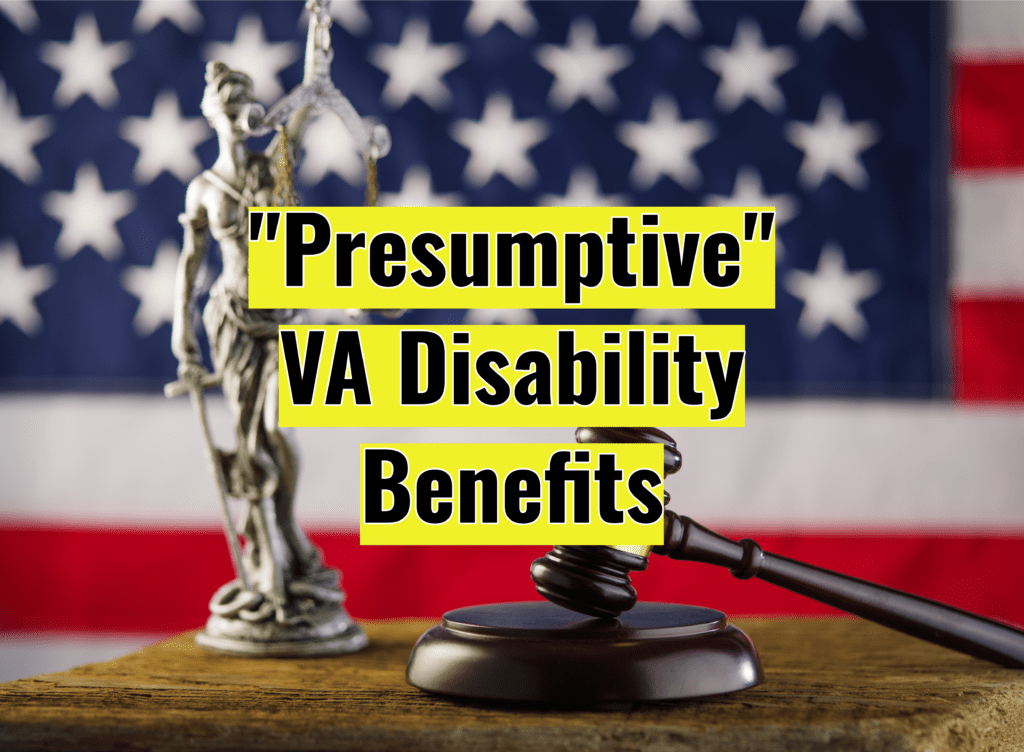
A presumptive condition is one that the VA “presumes” to be service-connected, even if there’s no specific “causation” or Nexus for service connection.
These claims are easy to win, assuming you can show via your DD 214 that you were deployed to an eligible location during a specific period, and you developed a qualifying disability condition as a result of your military service.
VA ratings for presumptive conditions range from 0% to 100%, depending on the condition and its severity of symptoms.
There are four main categories of veterans who qualify for presumptive disability conditions: (1) Vietnam veterans, (2) Atomic veterans, (3) Gulf War veterans, and (4) Gulf War veterans exposed to burn pits.
List of Vietnam Veterans Presumptive Conditions

This applies to Vietnam Veterans who were:
- Exposed to Agent Orange
- Served in the Republic of Vietnam or on a vessel operating not more than 12 nautical miles seaward from the demarcation line of the waters of Vietnam and Cambodia between Jan. 9, 1962 and May 7, 1975
For Vietnam Veterans, the VA considers the following conditions to be presumptive:
- AL amyloidosis
- B-cell leukemia
- Chronic lymphocytic leukemia
- Type 2 diabetes
- Hodgkin’s disease
- Ischemic heart disease
- Non-Hodgkin’s lymphoma
- Parkinson’s disease
- Prostate cancer
- Respiratory cancers
- Soft-tissue sarcoma (not including osteosarcoma, chondrosarcoma, Kaposi’s sarcoma, or mesothelioma)
- Chloracne or other similar acneform disease
- Porphyria cutanea tarda
Because of widespread exposure to Agent Orange, to include the waters around eligible locations known as “Blue Water Veterans,” the VA presumes that these conditions are service connected, and thus, you have an excellent chance winning these claims.
List of Atomic Veterans Presumptive Conditions

This applies to Atomic Veterans exposed to ionizing radiation and who experienced one of the following:
- Participated in atmospheric nuclear testing
- Occupied or were prisoners of war in Hiroshima or Nagasaki
- Served before Feb. 1, 1992, at a diffusion plant in Paducah, Kentucky, Portsmouth, Ohio or Oak Ridge, Tennessee
- Served before Jan. 1, 1974, at Amchitka Island, Alaska
For Atomic veterans, the VA considers the following conditions to be presumptive:
- All forms of leukemia, except chronic lymphocytic leukemia
- Cancer of the thyroid, breast, pharynx, esophagus, stomach, small intestine, pancreas, bile ducts, gall bladder, salivary gland, urinary tract, brain, bone, lung, colon or ovary
- Bronchioloalveolar carcinoma
- Multiple myeloma
- Lymphomas, other than Hodgkin’s disease
- Primary liver cancer, except if there are indications of cirrhosis or hepatitis B
List of Gulf War Syndrome Presumptive Conditions

This applies to Gulf War Veterans who:
- Served in the Southwest Asia Theater of Operations
- Have a condition that is at least 10 percent disabling by Dec. 31, 2021
For Gulf War Veterans, the VA considers the following conditions to be presumptive:
Medically unexplained chronic multi-symptom illnesses that exist for six months or more, such as:
- Chronic fatigue syndrome
- Fibromyalgia
- Irritable bowel syndrome
This also includes any diagnosed or undiagnosed illness that warrants a presumption of service connection, as determined by the Secretary of Veterans Affairs.
Signs or symptoms of an undiagnosed illness include:
- Fatigue
- Skin symptoms
- Headaches
- Muscle pain
- Joint pain
- Neurological symptoms
- Sleep disturbance
- GI symptoms
- Cardiovascular symptoms
- Weight loss
- Menstrual disorders
List of Gulf War Deployed Veterans Presumptive VA Conditions to Burn Pit Exposure

This applies to Gulf War Deployed Veterans exposed to Burn Pits who:
- Served in the Southwest Theater of Operations during the Persian Gulf War
- Served in Afghanistan, Syria, Djibouti or Uzbekistan on or after September 19, 2001
- Served any length of time in the qualifying area and a condition below becomes manifest to any degree within 10 years from the date of separation from military service:
For Gulf War Deployed Veterans exposed to Burn Pits, the VA considers the following conditions to be presumptive:
- Asthma
- Rhinitis
- Sinusitis, to include Rhinosinusitis
Click HERE to read about the 3 recently approved presumptive conditions to burn pit exposure.
#5. Gastroesophageal Reflux Disease (GERD)
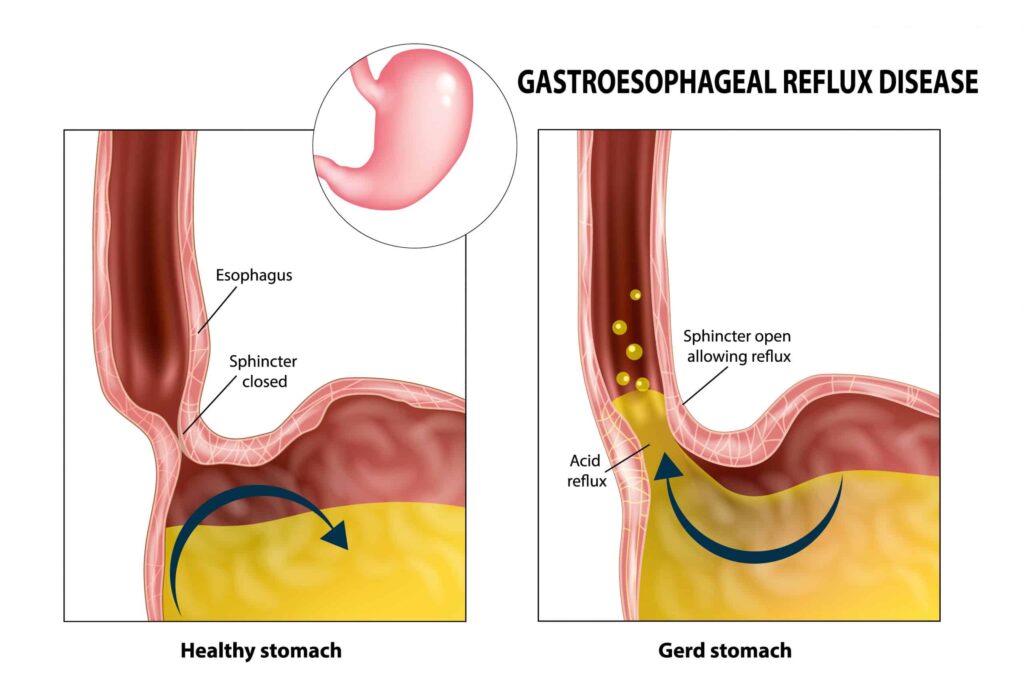
Gastroesophageal Reflux Disease (GERD) is very common in veterans and is one of the easiest VA disabilities to claim.
In 2023, a veteran’s VA rating for GERD can be 10%, 30%, or 60%, depending upon your frequency, severity, and duration of symptoms.
GERD occurs when stomach acid repeatedly flows back into the esophagus, which is the tube connecting your mouth and stomach.
When this happens, the lining inside your esophagus can become irritated due to the stomach acid.
This uncomfortable sensation leads to heartburn or acid reflux.
Many veterans have GERD, and according to the Mayo Clinic, common symptoms of GERD include:
- A burning sensation in your chest (heartburn), usually after eating, which may worsen at night
- Chest pain
- Difficulty eating and swallowing
- Regurgitation of food particles or sour liquid
- Sensation of a lump in your throat
- Chronic cough
- Laryngitis
- New or worsening asthma
- Disrupted sleep and insomnia
Pro Tip: GERD is a common secondary VA disability claim, especially GERD secondary to PTSD especially due to the side effects of medication taken to manage mental health symptoms.
Another easy claim to win is Sleep Apnea secondary to GERD.
#6. Irritable Bowel Syndrome (IBS)

Irritable Bowel Syndrome (IBS) is a very common disorder that affects a veteran’s large intestine; it is one of the easiest things to claim for VA disability.
VA ratings for IBS range from 0% to 30%, with an interim break at 10%.
A veterans final VA disability rating for IBS depends upon the frequency, severity, and duration of your symptoms, meaning, the more severe your symptoms, the higher the VA rating for IBS.
There is no separate diagnostic code for IBS, and it’s most commonly assigned a VA rating analogous to diagnostic code 7319, Irritable Colon Syndrome.
Symptoms of IBS include cramping, stomach pain, bloating, gas, diarrhea, and constipation.
The most severe symptoms of IBS can usually be treated and managed with medication.
The specific cause of IBS isn’t known within the medical community, however, there are common triggers that can cause or make IBS worse.
Deserve a HIGHER VA Rating? WE CAN HELP.
Join our premier education-based membership program, VA Claims Insider Elite, connect with an expert-level Veteran Coach (VC) within minutes, and finally get the rating you deserve. Click the button below to get started.
According to the Mayo Clinic, some common triggers of IBS in disabled veterans include:
- #1 Food. The role of food allergy or intolerance in IBS isn’t fully understood. A true food allergy rarely causes IBS. But many people have worse IBS symptoms when they eat or drink certain foods or beverages, including wheat, dairy products, citrus fruits, beans, cabbage, milk and carbonated drinks.
- #2 Stress. Most people with IBS experience worse or more frequent signs and symptoms during periods of increased stress. But while stress may aggravate symptoms, it doesn’t cause them.
- #3 Hormones. Women are 2x as likely to have IBS than men, which might indicate that hormonal changes play a role. Many women find that signs and symptoms are worse during or around their menstrual periods.
- #4 Medication Side Effects. Many over the counter and prescription medications taken to help manage a variety of physical and mental disabilities in veterans may cause IBS symptoms or make them worse.
Medical research does suggest a link between IBS and veterans with a mental health condition.
For example, PTSD anxiety, depression and other mental health conditions are associated with IBS and the severity of a veteran’s mental health symptoms may trigger IBS symptoms and make them worse.
Finally, many over the counter and prescription medications taken to help manage a variety of physical and mental disabilities in veterans may lead to IBS symptoms.
Pro Tip: Many veterans with IBS, especially those who were diagnosed long after leaving the military are eligible under the law for secondary service connection, including but not limited to: IBS secondary to PTSD, IBS secondary to Depression, and IBS secondary to Anxiety.
Click HERE to read our Top 3 Tips for IBS Claims.
#7. Migraine Headaches

According to the new VBA report to congress, Migraines were the #9 most commonly claimed and service connected VA disability condition for new compensation recipients.
In 2023, Headaches are rated at either 0%, 10%, 30%, or 50% depending upon the severity of your symptoms.
While the law only specifically lists “Migraines,” ANY type of headache condition can receive a VA rating if you have symptoms that affect your work, life, and functioning due to your military service or another service connected disability.
The International Headache Society and the Mayo Clinic have identified more than 150 different types of headaches, which are divided into three categories: Primary, Secondary, and Other.
For example, Tension Headaches are the most common type of headaches among adults, and the most common type of headaches in veterans as well. They cause mild to moderate pain and come and go over time.
Migraine Headaches are often described as pounding, throbbing pain, and they can last from 4 hours to 3 days and usually happen one to four times a month.
Along with the pain, veterans have other symptoms, such as sensitivity to light, noise, or smells; nausea or vomiting; loss of appetite; and upset stomach or belly pain.
Post Traumatic Headaches, for example, are quite common among veterans, specifically if you suffered from any type of head injury or trauma during military service.
Furthermore, post traumatic headaches, particularly migraine headaches, are commonly found in veterans who deployed in support of combat operations in Iraq and Afghanistan.
According to medical research, if you get a new headache within 7-10 days of a head injuryor after you are conscious again from the trauma, you may have a condition known as a post-traumatic headache.
Pro Tip: Headaches are often granted secondary service connection because Migraine Headaches are shown to be proximately due to or the result of another service connected disability. The frequency and severity of Headache Conditions typically increases with the severity of other service-connected disabilities. For example, veterans with more severe PTSD symptoms are likely to have more severe Migraine Headache symptoms, suggesting a correlation between the two.
Click HERE to learn more about Migraines and secondary service connection.
#8. Radiculopathy
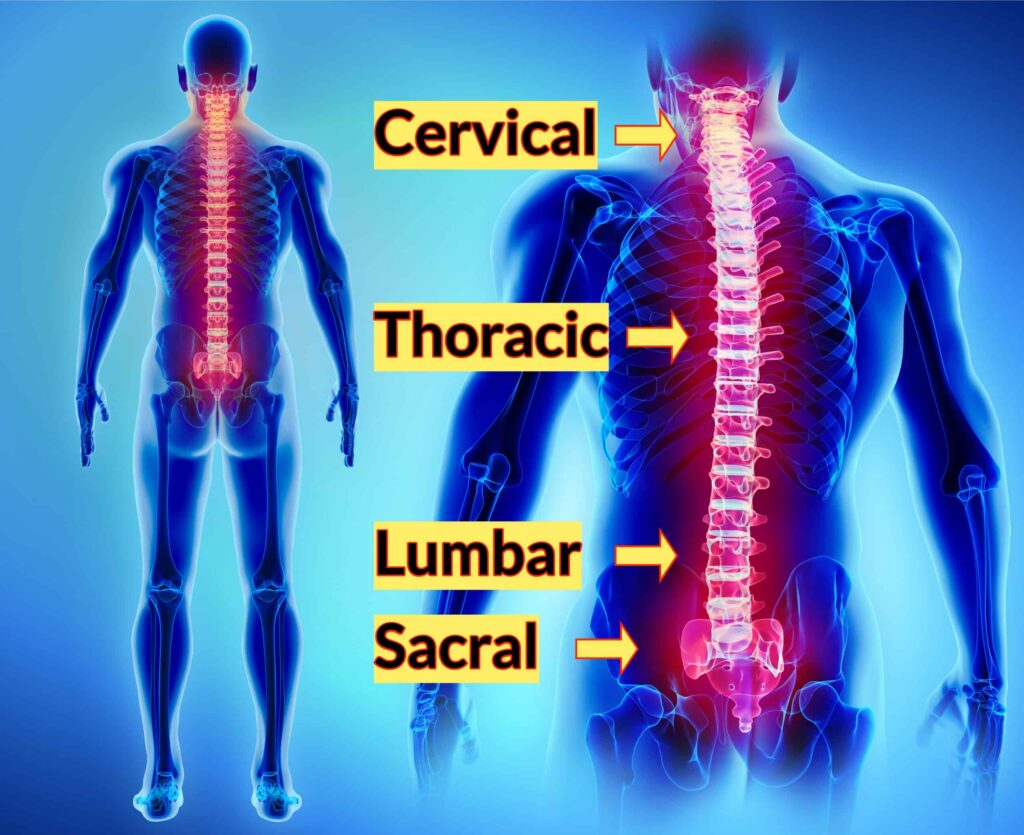
Many veterans suffer from Radiculopathy, and it’s also an easy VA claim to get service connected.
In 2023, VA ratings for Radiculopathy typically range from 0% to 70%, depending upon the severity of your symptoms.
However, a VA rating for Sciatica can range from 10% to 80%, depending upon the severity of symptoms.
The highest possible VA disability rating for Radiculopathy, across all radicular groups, with complete paralysis, is 90%.
Your spine is made up of many bones called vertebrae, and your spinal cord runs through a canal in the center of these bones.
Nerve roots split from the cord and travel between the vertebrae into many different areas of your body.
When these nerve roots become pinched or damaged, the resulting symptoms lead to a painful condition called Radiculopathy.
When a nerve root is compressed, it becomes inflamed.
This results in numerous unpleasant and painful symptoms in veterans that may include:
- Sharp and radiating pain in the back, arms, legs or shoulders that may worsen with certain activities, even something as simple as coughing or sneezing
- Weakness, fatigue, or loss of reflexes in the arms or legs
- Numbness or tingling of the skin, “pins and needles,” or other abnormal sensations (paresthesia) in the arms or legs
Your specific symptoms will depend on where in the spine the nerve root is pinched.
However, it’s also possible that you don’t experience any symptoms, or you go through periodic flare-ups of symptoms.
Pro Tip: Radiculopathy is a very common secondary VA disability claim for secondary service connection due to one or more service connected back or neck conditions.
Click HERE to read about VA disability claims for Radiculopathy.
#9. Plantar Fasciitis
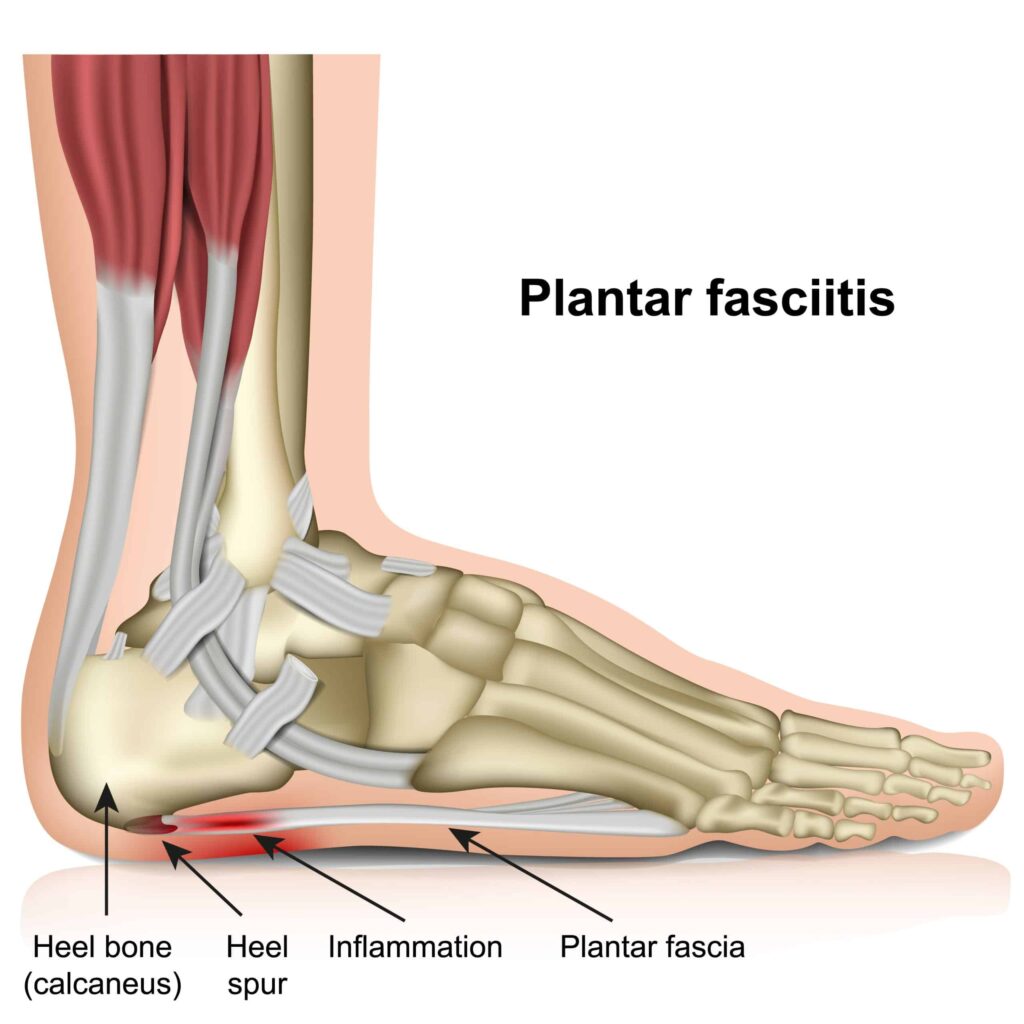
Plantar Fasciitis is one of the most common causes of heel pain in veterans. It’s also an easy VA claim to win.
Plantar Fasciitis is inflammation of the thick band of tissue that runs across the bottom of your foot and connects your heel bone to your toes (called the “Plantar Fascia”).
In 2023, Plantar Fasciitis has its own Diagnostic Code (DC) 5269 with ratings that range from 10% to 30% with a break at 20%.
The highest possible scheduler VA disability rating for bilateral Plantar Fasciitis is now 30% (not 50%), which includes symptoms such as no relief from both non-surgical (orthopedic shoes or appliances) and surgical treatment.
However, if the veteran has actual loss of use of the foot, the rating is 40%.
A veterans final VA disability rating for Plantar Fasciitis depends upon the frequency, severity, and duration of symptoms, meaning, the more severe your symptoms, the higher the VA rating for Plantar Fasciitis.
There is also a bilateral factor—meaning veterans can get a higher VA rating for Plantar Fasciitis if they have the disability in both feet.
According to the Mayo Clinic, “Your plantar fascia is in the shape of a bowstring, supporting the arch of your foot and absorbing shock when you walk. If tension and stress on this bowstring become too great, small tears can occur in the fascia. Repeated stretching and tearing can irritate or inflame the fascia, causing severe heel pain.”
Common risk factors include age, long distance running (such as military PT), poor arch and heel support (e.g., military combat boots), obesity, and occupations that require a lot of standing (active duty military service, perhaps combat deployments).
Pro Tip: Many veterans with Plantar Fasciitis, especially those who were diagnosed long after leaving the military, might still be eligible if medical evidence shows your heel pain is proximately due to or aggravated by another service-connected disability such as knee strain, hip conditions, and/or back conditions.
Click HERE to read about VA Claims for Plantar Fasciitis.
#10. Erectile Dysfunction (ED)
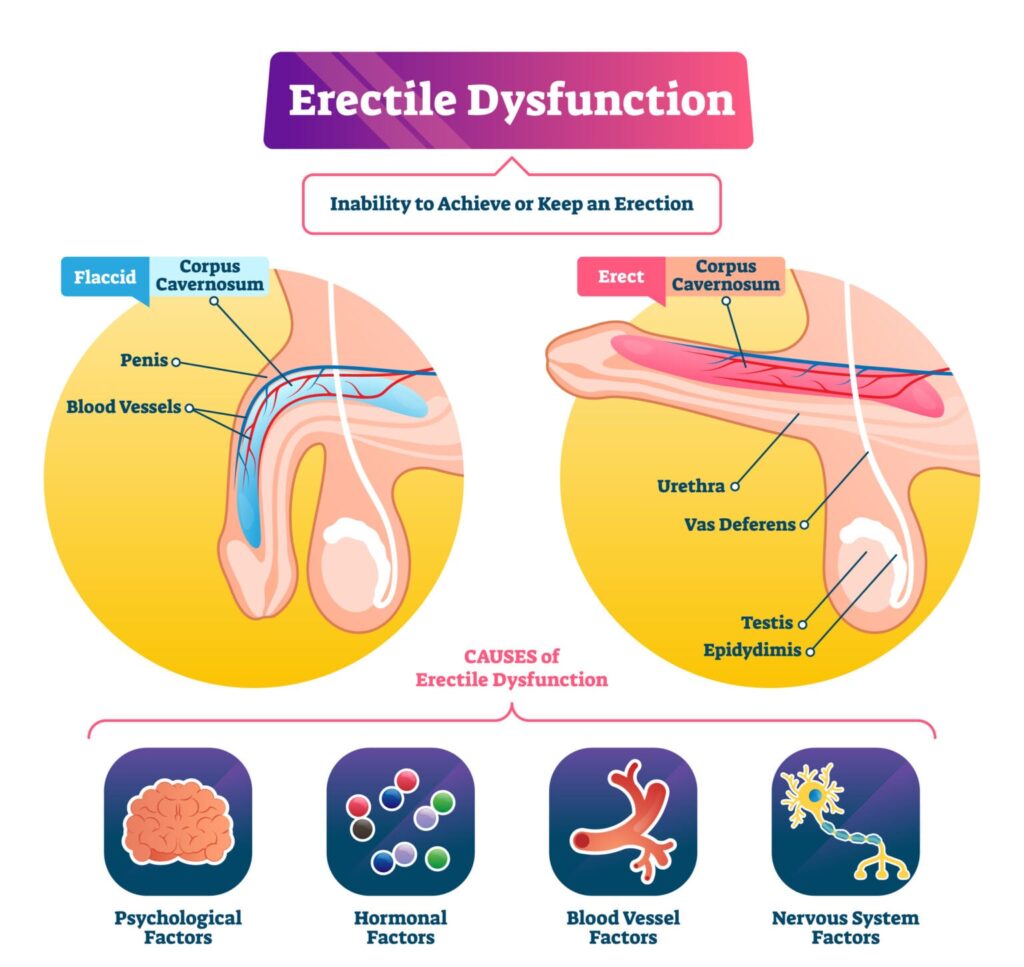
Many Veterans suffer from Erectile Dysfunction from active duty service, and there are a variety of physical and mental conditions that can cause or make ED worse.
For example, Erectile Dysfunction is a common claim for secondary service connection, especially secondary to mental health conditions such as PTSD, Depression, and Anxiety.
In addition, side effects of medications you take to manage your physical and mental health symptoms can cause or make ED worse.
Erectile Dysfunction is assigned a 0% service connected VA rating under Special Monthly Compensation (SMC) Category (K) or SMC-K, for “Loss of Use of a Creative Organ.”
In 2023, Veterans with a 0% rating for Erectile Dysfunction qualify for SMC-K and will get an additional $118.55 per month added to their total monthly VA disability compensation payment.
According to the Mayo Clinic, Erectile Dysfunction (ED) is the inability to get and keep an erection firm enough for sexual intercourse.
If you’re a Veteran suffering from ED, it can cause a significant amount of stress in your life, affect your well-being and outlook on life, and can contribute to relationship problems.
Common symptoms of Erectile Dysfunction in Veterans include:
- Difficulty getting an erection
- Difficulty keeping an erection
- Decreased libido (low sex drive)
If a Veteran is going to file an Erectile Dysfunction VA claim, he/she must present medical evidence that shows all three of the following:
- Tip #1: Make sure you have a medical diagnosis of Erectile Dysfunction in a medical record, AND
- Tip #2: You must have a “Nexus” for service connection, meaning, your Erectile Dysfunction was caused or made worse by your active duty military service OR your ED is “proximately due to or aggravated by” another service connected disability rated at 0% or higher, AND
- Tip #3: Current symptoms of Erectile Dysfunction that negatively impact your work, life, or social functioning documented in a medical record. It also helps to write a strong personal VA statement in support of a claim.
Become an Insider
We’re Veterans helping Veterans Worldwide™, and since 2016 we’ve helped 10,000+ Veterans just like you INCREASE their VA disability rating!
Erectile Dysfunction Secondary Claims for Disability
Pro Tip: In many cases, Erectile Dysfunction is caused by something physical or mental, and can be rated secondary to any of the following service connected conditions:
- PTSD
- Depression
- Anxiety
- Adjustment Disorder
- Somatic Symptom Disorder
- Any other mental health condition
- Heart disease
- Clogged blood vessels (Atherosclerosis)
- Hypertension (High Blood Pressure)
- Diabetes
- Obesity as an “interim link” for secondary service connection
- Parkinson’s disease
- Multiple sclerosis
- Certain prescription medications
- Peyronie’s disease (scar tissue inside the penis)
- Various sleep disorders (Insomnia, Sleep Apnea, etc.)
- Treatments for prostate cancer or enlarged prostate
- Surgeries or injuries that affect the pelvic area or spinal cord
- Low testosterone
Click HERE to read our definitive guide on VA claims for Erectile Dysfunction.
Medical Evidence and Supporting Documentation Are Critical

To maximize your chances of winning your VA claims, medical evidence and supporting documentation should be an important part of your VA claim strategy.
If you’re still on active duty, get your butt to the doctor, and have your injuries or conditions documented in your military medical records. Do this now and don’t wait until you’ve left the military.
If you are out of the service, and already a veteran, work with your private doctor to diagnose your condition, and document the severity of your symptoms in either VA or private medical records.
It’s important for you to write strong personal statements to support each disability you’re claiming before the VA.
It can also be helpful to have a friend, relative, coworker, or veteran you served with write a VA Buddy Letter as a first-hand witness to the event or injury that caused your disability.
Want to Work With a VA CLAIM EXPERT?
At VA Claims Insider, we help fellow Veterans celebrate LIFE CHANGE by getting them the VA disability rating and compensation YOU DESERVE by law.
And, you’ll get to work with a Veteran Coach (VC) who will lead you to VA claim success.
- We’re a company OF Veterans, BY Veterans, FOR Veterans! FOR Veterans, BY Veterans. We’re the largest community of Veterans Helping Veterans Worldwide™
- 25,000+ disabled veterans served in our Elite Membership program since 2016 with and average VA disability rating increase of >30%
- 4.8/5.0 Google Reviews rating across 2,000+ total reviews
Click HERE to Join the #1 Rated VA Claims Insider Elite Program and Start Today for FREE.
You DESERVE a HIGHER VA rating.
Take advantage of a VA Claim Discovery Call with an experienced Team Member. Learn what you’ve been missing so you can FINALLY get the disability rating and compensation you’ve earned for your service.
About the Author

Brian Reese
Brian Reese is a world-renowned VA disability benefits expert and the #1 bestselling author of VA Claim Secrets and You Deserve It. Motivated by his own frustration with the VA claim process, Brian founded VA Claims Insider to help disabled veterans secure their VA disability compensation faster, regardless of their past struggles with the VA. Since 2013, he has positively impacted the lives of over 10 million military, veterans, and their families.
A former active-duty Air Force officer, Brian has extensive experience leading diverse teams in challenging international environments, including a combat tour in Afghanistan in 2011 supporting Operation ENDURING FREEDOM.
Brian is a Distinguished Graduate of Management from the United States Air Force Academy and earned his MBA from Oklahoma State University’s Spears School of Business, where he was a National Honor Scholar, ranking in the top 1% of his class.




